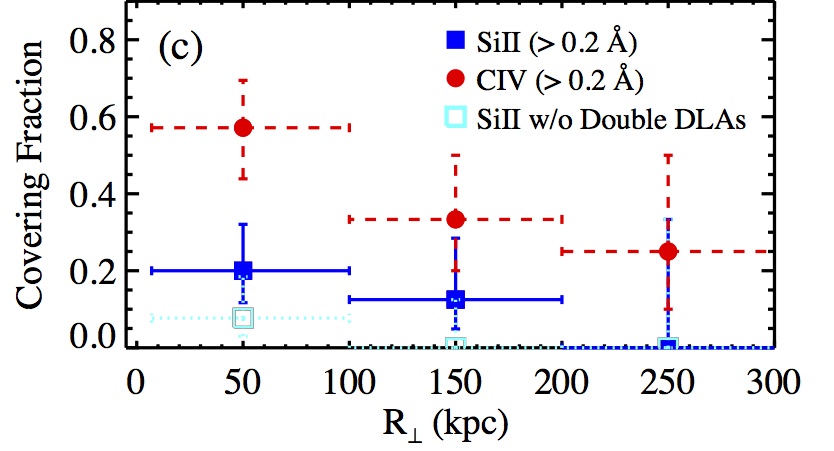I’m also interested in the properties of the gas that surrounds galaxies over large scales (i.e., hundreds of kiloparsecs), as this “circumgalactic medium” (CGM) acts as the reservoir to feed future galaxy growth. The gas, although it is quite diffuse, can be effectively probed in absorption toward bright quasars in the background. And actually, we can use quasar absorption line signatures to locate and study both the host galaxy and its CGM, thanks to the large spectroscopic sample of close, high-redshift (z>2) pairs of quasars my collaborators and I have built up (check it out at qpqsurvey.org).
We have searched these quasar pair sightlines for instances of foreground absorption with exceptionally large neutral hydrogen column densities called damped Lyα (DLA) systems. Such systems indicate the likely presence of a nearby star-forming galaxy (although it is difficult to guess the luminosity of this galaxy, as DLAs are known to be associated with both dwarf-like systems and brighter Lyman Break Galaxies). The second quasar in each pair then probes the CGM of the DLA. For instance, in the schematic shown above, we use a quasar pair at z=2.1 and separated by ~60 kpc on the sky to detect DLA absorption in the blue (top) sightline at z=1.967. The lower (green) quasar sightline probes the DLA’s CGM. At right, we show the corresponding quasar spectra. The DLA is evident in the top spectrum (marked in purple), with associated low- and high-ionization metal lines marked with different colors. The lower quasar spectrum exhibits these same absorption lines, revealing cool, metal-enriched gas extending to at least ~60 kpc from the DLA-galaxy.
We’ve now analyzed CGM absorption around a sample of 40 DLAs to a projected distance of 300 kpc. The figure above shows a couple of our main findings. Strong absorption due to cool gas traced by low-ionization metal-line transitions (i.e., SiII) is quite rare in these environments, occurring in only ~20% of our CGM sightlines within 100 kpc of a DLA (see dark blue points above). However, strong absorption from high-ionization transitions (i.e., CIV) is more common (red points), and extends over much larger scales. This high-ionization absorption also tends to occur at the same velocities and even with similar velocity structure in both quasars in a given pair, suggesting that the material arises in large, quiescent structures rather than in ongoing galactic winds. Please keep an eye on astro-ph for more details on this work.

